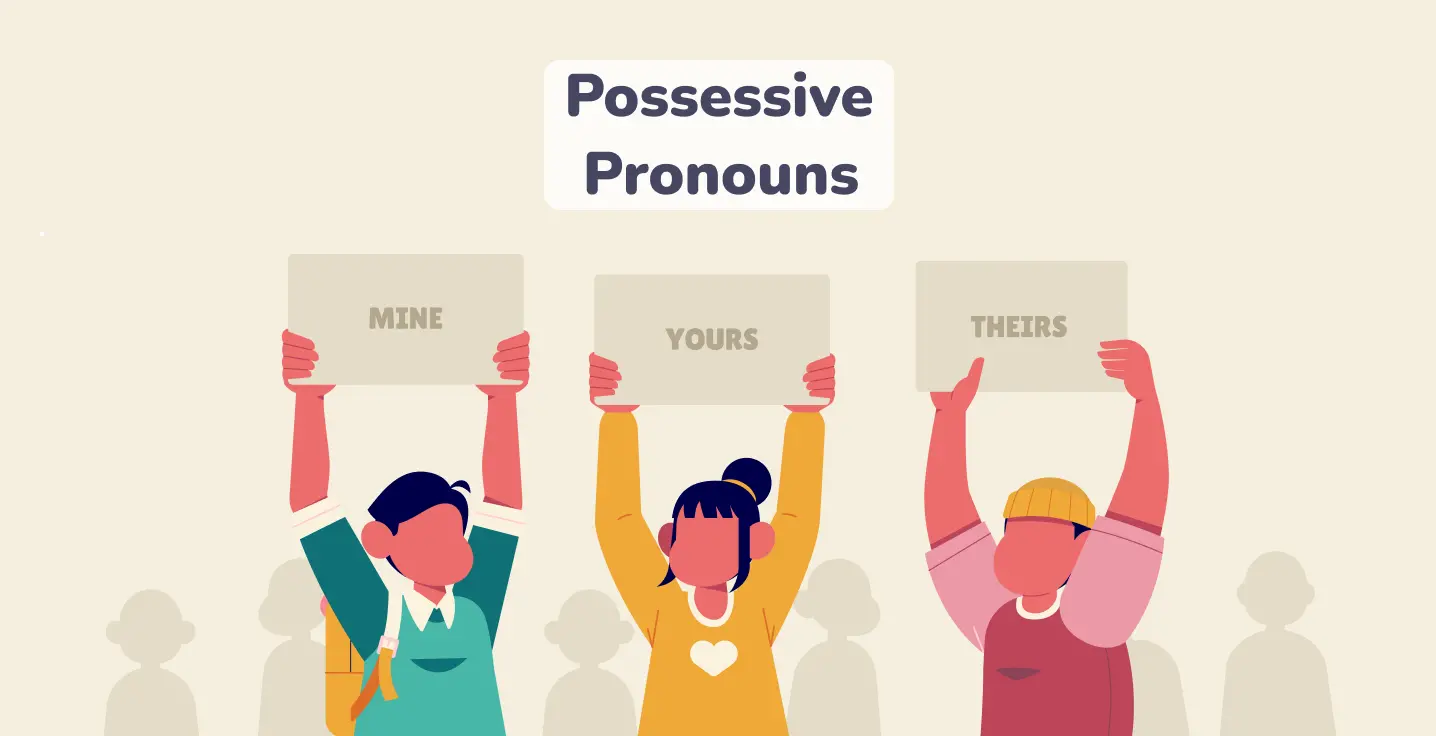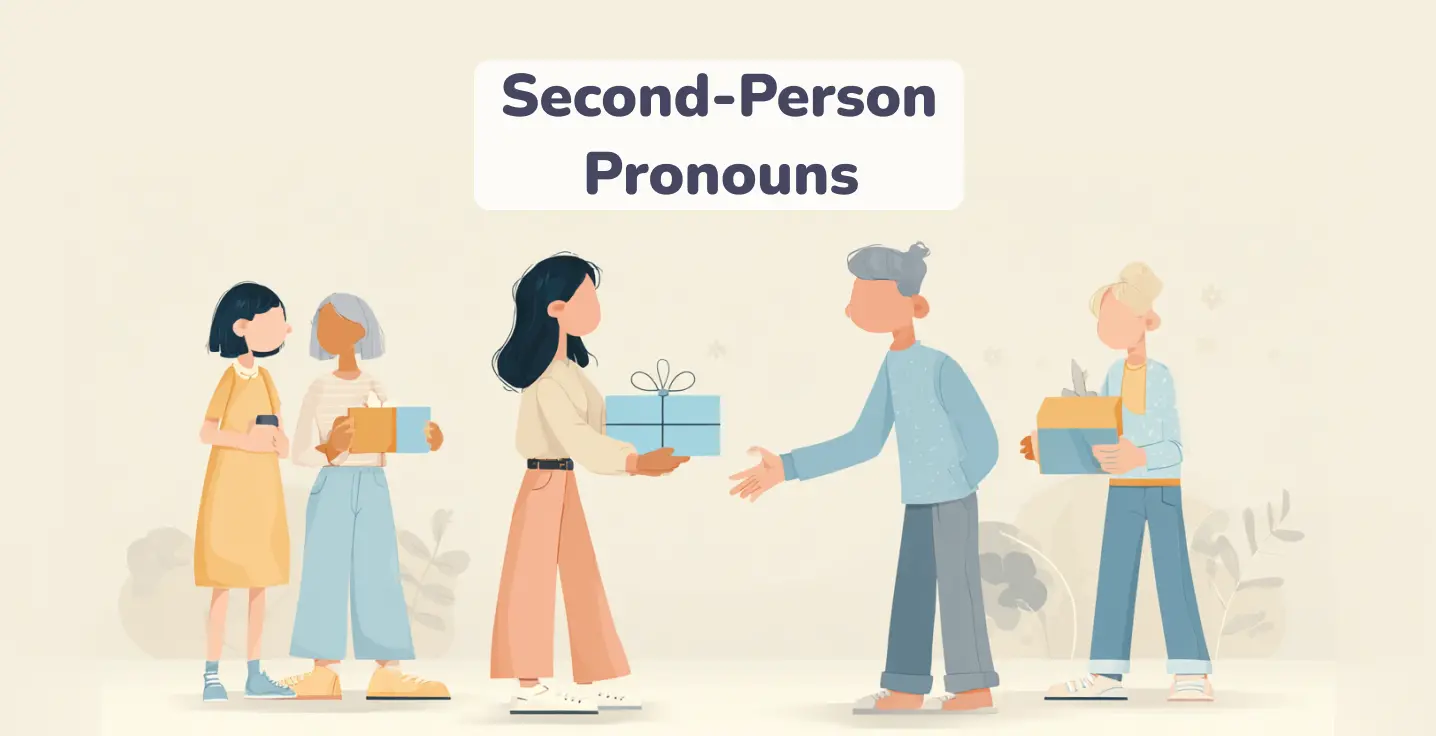What is a plural noun?
This widely used term stands for a special word that speakers apply to sentences when they want to talk about things, people, animals, etc., that are more than one.
How to recognize these terms in a text or when speaking? Look for the pattern -s or -es at the end of a word — that’s the most common formation across plural noun rules. Here are some more examples:
To get a better understanding of what differentiates plural and singular nouns, you need a simple scheme:
singular → one (book, presentation, mother)
plural → two or more (books, presentations, mothers)
Further, you will learn all about the kinds of terms with a plural nouns list with samples and detailed descriptions. Let’s move on to the next topic.
Level up your English with Koto!
Types of plural nouns
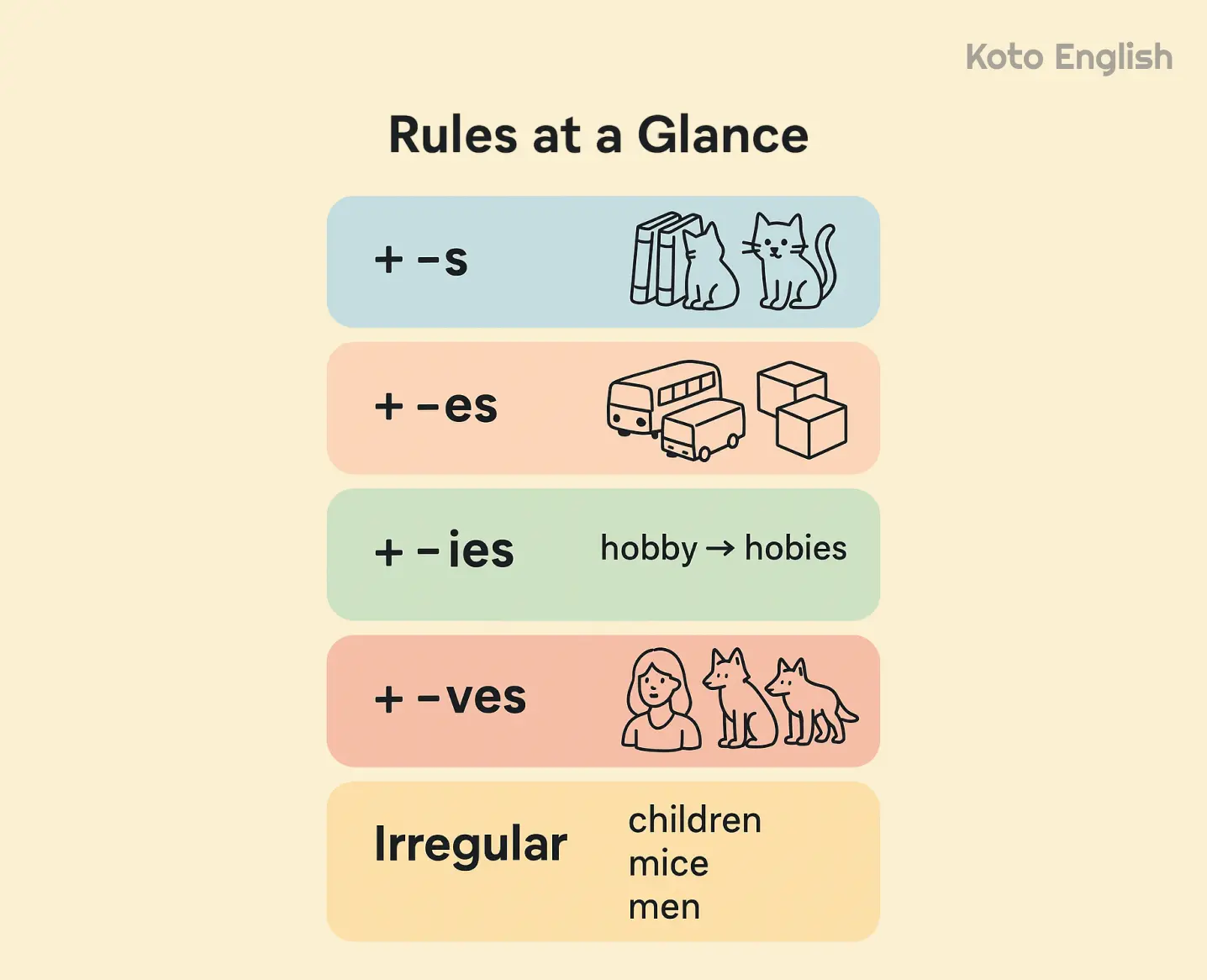

Being accurate in English means you need to study all kinds of plural words, which will also develop your writing, reading, and speaking skills. Here, you will review the four core types with examples of sentences that are used by native speakers.
Take a look at the plural nouns examples in our informative and straightforward table:
| Type | Description | Examples |
|---|---|---|
| Regular | Adding -s or -es (depending on the noun ending -s, -h, -x, -y, -ch) |
note → note
video → video
comment → comment
bus → bus
|
| Irregular | Have unique forms in plural. |
foot →
woman →
person →
|
| Zero (no change) | These words stay the same in every form |
sheep →
series →
buffalo →
|
| Only plural form | They cannot be changed into a singular form |
scissors
thanks
glasses
pants
headphones
|
As you can see from the information above, the usage of plural kinds is both simple and complex. First of all, there are obvious regular words where you can easily change the ending.
Irregular nouns can be difficult as there are no particular rules, and you need to memorize them. One of the best ways to do it is to learn through the context of books, texts, dialogs (all the plural nouns are here!), and even music.
Zero kind also needs to be studied by heart, and there are not many of them, so you can also practice more by using the environment, telling about things that surround you, which you can see in a store, office, school, etc.
There are also nouns which are used in plural form only, and — not a surprise — you need to remember them while doing some activities (like a plural nouns worksheet).
Further, you will learn more about the grammatical rules and unique situations that will help you to become more fluent in English and move on to more complex structures in the future.
Basic rules for forming plurals
“What are plural nouns?” is a tricky question for new learners, which you answered, but how to write them correctly? The types table above has a simple explanation, so here, you will focus on the actual rules that will help you make the word formation a piece of cake.
Simply, you just need to change the ending part of a term, but English is a tricky language, and there are some nuances. Let’s start with a fundamental regulation.
-
Add -s/-es
Sounds good and easy-peasy, and it is true as you take the word in its original (singular) form and add the suffix -s or -es:
animal → animals vinyl → vinyls job → jobs progress → progresses -
Add -ies instead of -y
Many nouns have vowels at the end, so you have to know how to operate with them when talking about a few things or people. This is how it works:
berry → berries hobby → hobbies study → studies -
Changing -f/-fe to -ves
Another little confusing rule that you need to learn is that nouns with -f or -fe endings also change their form when put in plural, and here are the samples:
knife → knives thief → thieves hoof → hooves loaf → loaves
Learning these spelling and writing rules, you will be able to memorize them more easily, and make no mistakes when it comes to real conversations, tests like IELTS, and other exams.
Special cases
What would English be like without exceptions, right? So, here are some of them that refer to the rules for plural nouns that go beyond typical -s and -es adding. The words we will consider today are special and widely used as well, especially if you are an active user of social media and a reader. Let’s start the explanation:
-
Latin and Greek forms for borrowed words
Adopting other terms from languages like Latin is a common thing for English, and this heavy impact also takes place in plural terms. You may know the word “mile” already, but today, we will focus on those special ones that differ in singular and plural.
cactus (Latin) →cacti/cactuses criterion (Greek) →criteria crisis (Latin) →crises -
Collective nouns in plural
Some examples of plural nouns that tell us about groups of living creatures are surprisingly easy to make, as you need to use the first rule you studied above:
audience → audiences committee → committees band → bands -
Rare noun forms
Despite the fact that we called them “rare” and “unusual,” you can find these words literally everywhere, even in this article above! Here are more examples you may find interesting:
man → me nmouse →mice child → children
There are also some ancient terms that are no longer commonly used in our time, so you can learn them out of curiosity.
Plurals in compound nouns
These words (two or three in general, which can also be connected with “-” dash or written together) are also popular, and making plural forms seems more complicated. New learners ask, “Where should I put the -s or another suffix?” Here are the plural noun examples for more understanding:
You are a master now! Next, you will learn about the errors that take place in language studying, even among experienced speakers.
Common mistakes and confusions
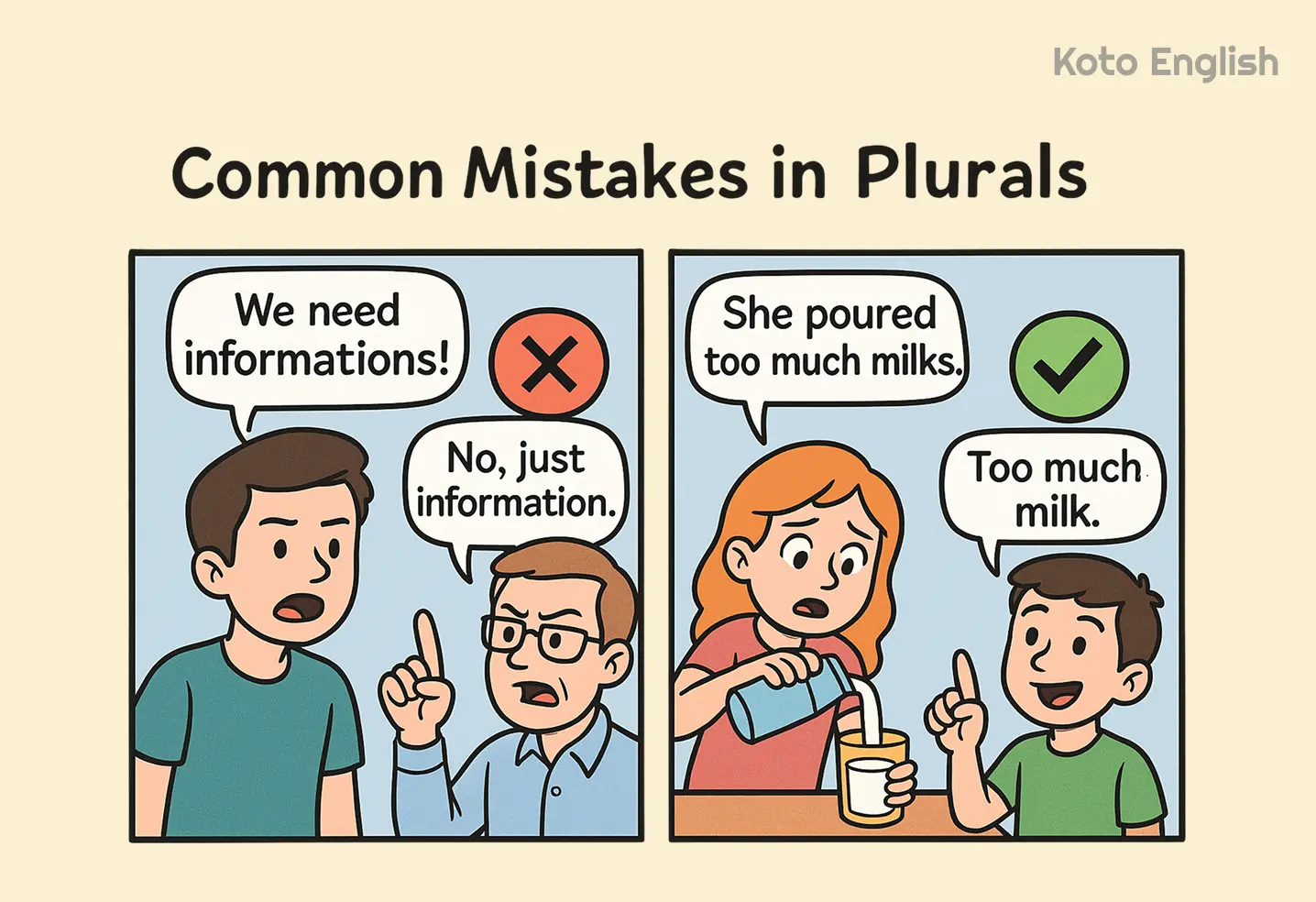
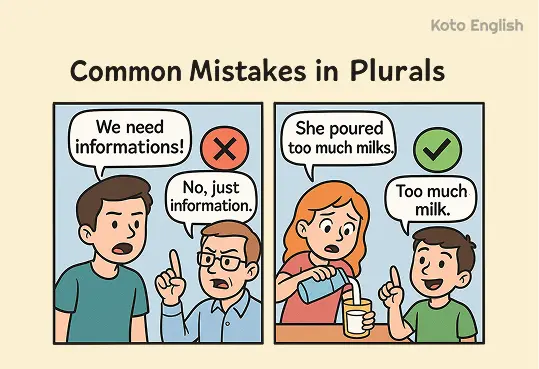
There are many reasons why making mistakes is useful when learning the list of plural nouns, and the core one is that you are able to memorize more and increase your confidence, as you will be aware of errors.
That’s why, today you will study the three usual mistakes made by almost every learner and even some native speakers.
Overusing -s for all words
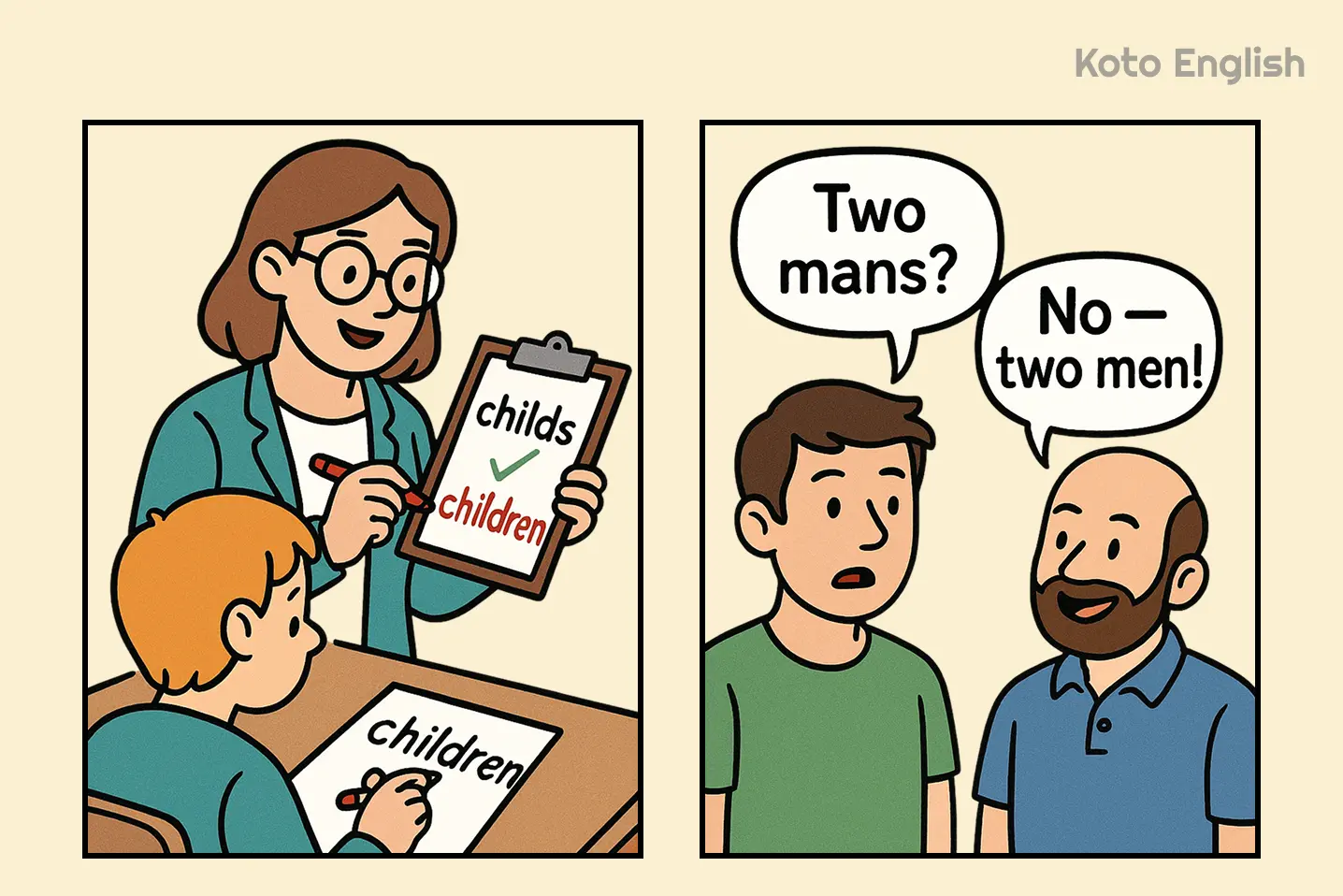
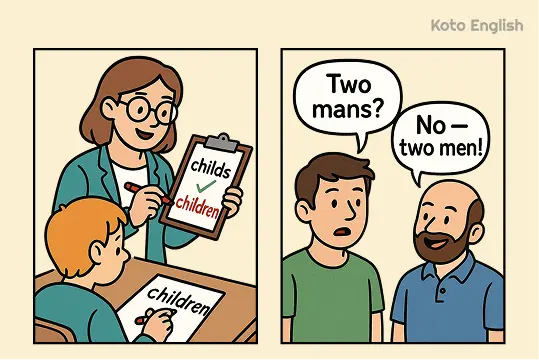
Sometimes, when learning the core rule of adding -s to a term in the singular, students decide to ignore all other regulations and go with the one they know. For instance, some words are fully changed when put in the plural form, and others stay the same, so the irregular plural noun list is different from the regular ones. Here is how it works:
|
The teacher gave us a lot of homeworks.
|
The teacher gave us a lot of homework.
|
|
This family has four childs.
|
This family has four children.
|
Confusing countable vs. uncountable nouns
Another important point about adding -s or -es to terms that can not be counted is that it can lead to a large mistake that could cost you points during an exam or result in a misunderstanding by your listener.
You need to learn about uncountable words and memorize them to be able to recognize them in texts, and also be aware of some tricky words.
Let’s check the examples:
|
We need informations about this case.
|
We need information about this case.
|
|
She poured too much milks.
|
She poured too much milk.
|
Mixing up irregular nouns
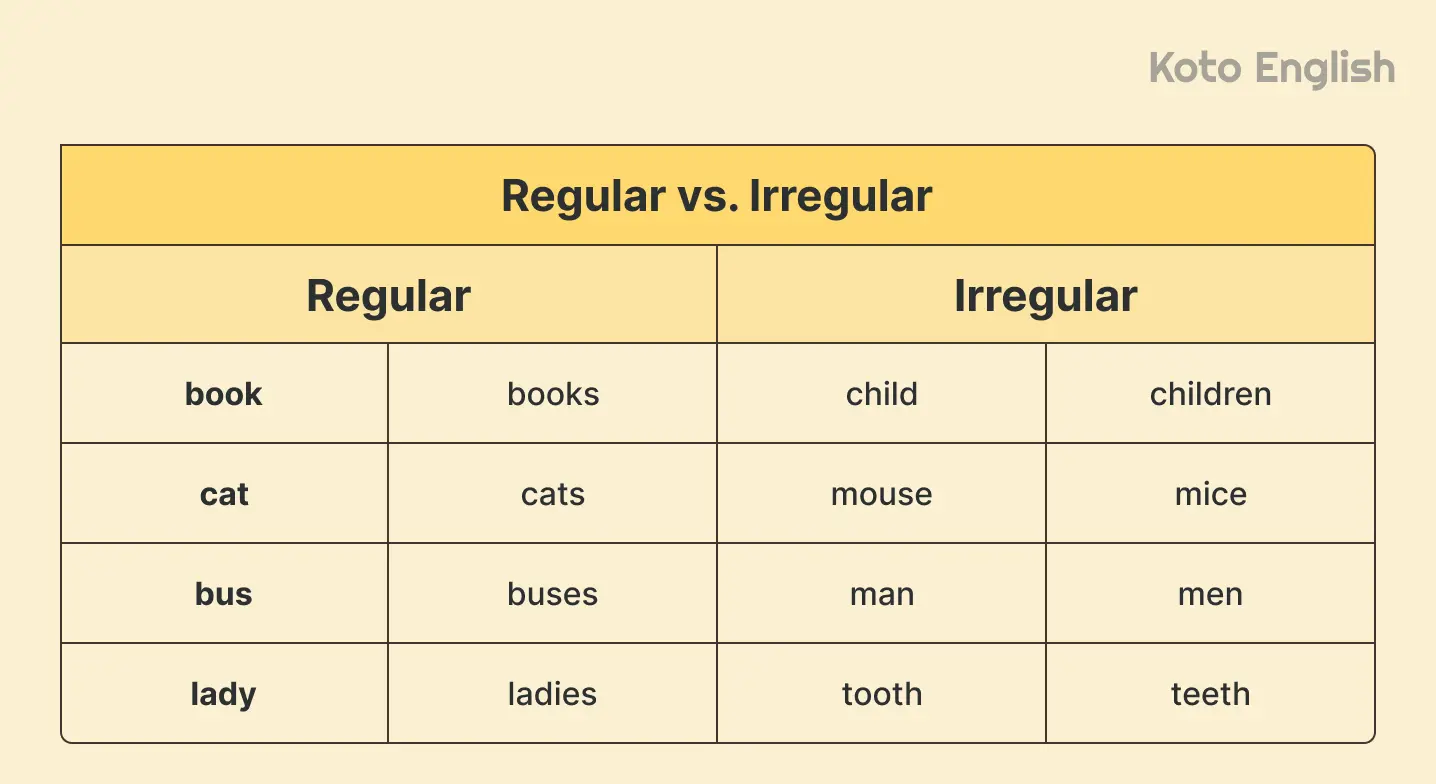

It will work in most cases, but after reading the previous part of this material, you already know that irregular nouns don’t change like this. Here are some samples for plural nouns rules:
|
I hate brushing tooths.
|
I hate brushing teeth.
|
|
Two mans are waiting for us.
|
Two men are waiting for us.
|
Now, you can avoid all the mistakes that are common for learners, as the process of identifying and correcting errors improves your fluency and problem-solving skills, which are crucial for learning complex English concepts in the future.
Tips for remembering plural forms
Getting a clear direction when learning the plural nouns definition and rules means you will make it fast. A clear roadmap will also keep you engaged in the process, so here are the recommendations you need to enhance your study:
- Practice in contexts. It is the best way to remember tricky irregular nouns and their plural forms, as you will read/listen/write them within something that is helpful and interesting for you. For example, you can do exercises and identify these words when listening to your favorite band or reading an article you like.
- Gamify the process. With a learning app like Koto, you can easily remember the plural noun meaning and rules while playing with English through activities you like: earning badges, competing with other learners, practicing real-world vocabulary, and more.
- Visualize your patterns. It may be difficult to learn all the regulations with just pen and paper, so it can be a way to make flashcards (digital or physical) which you can review anytime you have a few minutes, or make a cheat sheet (but not for the exam) as when you will write it down, you will memorize automatically.
Use these recommendations, and you will be able to make the learning process more effective, without extra stress, by paying attention to consistency.
Conclusion
From a plural noun definition to common rules and plural non-changeable forms, you learned everything needed to be a professional in this grammar point. Keep practicing to boost your confidence and expand your vocabulary for writing, listening, and reading skills.
If you would like to study more grammar, keep reading our materials and practice daily using the worksheets from articles you will find on Koto! See you in another article.
Enjoy personalized learning!
Possessive pronoun FAQ
All of them are used to make a plural form according to the state of a noun and its specifications, so you need to remember the following ones:
- Add -s to the base of a form, which works in most cases: client → clients, wipe → wipes.
- Use -es with endings –s, -x, -z, -ch, -sh for smoother sound: boss → bosses, match → matches.
- Write -ies with ending -y to add more sonority: trophy → trophies, melody → melodies.
- Change -f/-ef ending to -ves as in most variants, you will make it like this: wife → wives, wolf → wolves.
- Study irregulars as they can not be explained by a particular rule: foot → feet.
Actually, no, in most situations, they can’t, and you don’t need to learn additional rules, just some concepts that can be used in modern English. Here is a plural noun example that explains how it works:
The second variant can be used in informal communication, but if you are about to take an exam, the advice is to stick to the rules.
It is children, though it sounds like a singular too, but you need to take into account that it is an irregular noun, so you need to just memorize it and move on to the next similar word. Here are some examples:
In the way that suits you the best: through similar rules, regular practice with engaging activities, communication with friends or relatives, remembering words through the context of what surrounds you daily (or what will be helpful for your goal, like a job interview where you need to operate with specific nouns).
Choose what suits your lifestyle and learning preferences, like making cards with different forms of nouns, using mnemonic devices and tricks, and so on.





